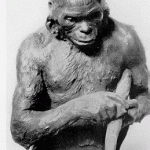How to measure snow by taking a core sample. Read Sara’s past articles about snow measuring here
Full transcript of video:
Hello, I’m Sara Bruegel writer of Creation Clues, and today I’m going to show you how to take a core sample of snow or ice. I have the outer cylinder of my rain gauge, my “snow swatter”, and a ruler for measuring the snow depth. So come on and let’s go ahead and take a look at it . . .
Okay, so as we come closer here, this is my snow board that we have. It’s underneath all the snow, so you can’t really see it, so I have this stake to mark where it is. We’re going to put this cylinder, the outer cylinder, upside-down on the board – make sure it’s down all the way, so it gets in all the snow, and we use the snow swatter here (or you can use your glove) to clear away any of the snow until we get to the snow board down there. The “snow swatter” helps us get directly underneath it and flip it. Now we have our perfect core sample in there, and this is our snow board underneath it. We’re going to clear away some of the rest of the snow and measure how much snow is on top of our board. Looks like about 2.4 inches right now.
Now that we have our core sample measured, and the depth of the snow on the snowboard, we’re going to clear away the rest of the snow from the snow board so that we can start over with a fresh sample tomorrow. Notice the snowboard is white – it matches the snow. We want it to match the snow so that it . . . reflects the sun’s heat in the same way that the snow around it does. So we’re going to move the snow board to a fresh location, right there, brush off the snow, and then stake it. And we’re done! We’re going to take this in and we’ll melt it.
Now that we have our core sample of the snow, we’re going to melt it down to figure out what the “snow-water-equivalent” is – meaning how much water is in this snow. To do that, we’re going to melt it with hot water, just from the tap. We need to measure how much water – how much hot water – we’re adding. Right here, we have – reading from the bottom of the meniscus (that’s that curve at the bottom) – we have point six-three (0.63”) inches of hot water we’re adding. So we just pour it in and shake it around to start melting the snow. It still has a ways to go in melting, so we’re going to add some more. But, first we need to write down [what] how much we added.
By the time we actually got the snow melted, we ended up having to add exactly two inches of warm water, so we’ll subtract that out of the water equivalent measurement we get out of this. To measure the water equivalent, we’re going to take the funnel from the rain gauge and the inner cylinder, and we’re going to start measuring a little bit at a time. There’s point nine-four (0.94”). We’re going to dump that out and take note of it, and we just keep on measuring a little bit a time.
Okay, so after adding together all those measurements, we got, and subtracting how much hot water we added (2 inches), we measured two point seven-eight (2.78”) and minus the two inches we added, we have point seven-eight (0.78”) inches. So that’s point seven-eight (0.78) inches worth of water out of that much snow that we found in the core sample. That’s how you take a core sample, and we also caught, in the outer cylinder, we caught snow just regularly, and got point eight-four (0.84) inches worth of snow-water equivalent. So comparing that to our point seven-eight (0.78”), they’re pretty close. That means we got a pretty accurate measurement.
Here are the tools we use to measure snow. We have the official CoCoRaHS [stands for “Community Collaborative Rain, Hail, and Snow Network] rain gauge. Now this is just like the rain gauge used by the National Weather Service, only it’s half the size and is made out of clear plastic instead of metal. The clear plastic helps us see through it. Mine is pretty old, so the plastic is pretty foggy and beaten-up. It has three components: there’s the funnel, it fits on the top, and the outer cylinder and inner cylinder. The inner cylinder precisely measures how much rain we got in hundredths of an inch. The whole inner cylinder can only hold one inch, and any rain over that spills out into the outer cylinder the bigger part there.
When we measure snow, we just put the outer cylinder outside so that the inner cylinder, that’s smaller, and the funnel, don’t get clogged up with all the snow. And then we bring it in and melt the snow to figure out how much water we got out of it. You also are going to want a snow swatter, which is a cheap flyswatter basically, that you use to move the snow, and a ruler to measure how deep the snow is in different places.
Now that we measured the core sample and measured what was in the rain gauge, we’re going ot put the outer cylinder back outside, here on the bracket so that we can measure any new snowfall that comes in here, and we do the same thing measuring that. Sometimes the snow gets piled up all around the edges, and the way we fix that is we just hit it with our flyswatter and what falls in we measure, what falls out we don’t.
Copyright Sara J. Bruegel, December 2015




